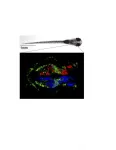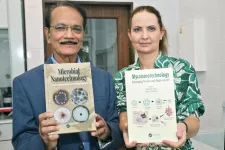(Press-News.org) The zebrafish brain, though simpler than its human counterpart, is a complex network of neurons that engage in a ceaseless dance of electrical activity. What if this neural ballet could reveal the secrets of how brains, including our own, control movement? A zebrafish study led by researchers at the Champalimaud Foundation offers a new lens through which to view the activity of neural populations, and to understand how the brain orchestrates motion.
Why we have a brain
“The brain’s primary function is movement”, explains Claudia Feierstein, lead author of the study published today in Current Biology. “Plants don’t need a brain because they don’t move. Yet, even for something as seemingly simple as eye movements, the brain’s role remains largely enigmatic. Our goal is to illuminate this ‘black box’ of motion and to decode how neural activity controls eye and body movements, using zebrafish as our model organism”.
With their tiny transparent bodies, zebrafish have become the darlings of neuroscience, offering a unique window into brain function. “Eye movement is a circuit that’s conserved across species, including humans”, notes Feierstein. “If we can understand how it works in zebrafish, we can start to understand better how human brains do movement”. Zebrafish, like humans, possess an innate ability to stabilise their vision and position in response to movement. When the world around them spins, their eyes and body move in tandem to maintain stability. This is akin to us steadying our gaze on a fixed point while on a merry-go-round.
But how does the brain coordinate this behaviour? Previous research by the team had shown that different parts of the zebrafish brain were associated with different types of movements. However, the precise relationship between these brain areas and the actual behaviour remained unclear. “While we know that neurons are involved in detecting visual stimuli (the input) and controlling muscles (the output), we remain in the dark about the processing in between”, remarks Feierstein. Complicating matters is the plethora of stimuli to which neurons respond and the staggering amount of data captured by whole-brain imaging studies. “When you have tens of thousands of neurons and 100 different possible behaviours that they could encode, it’s not trivial to understand what is going on”.
As Michael Orger, one of the two senior authors, elaborates, “When you look at the activity of individual neurons, you find that they can respond to multiple behavioural variables. This makes it challenging to pinpoint what exactly is driving their activity”. This leads to a complex interplay between neurons and behaviour, where individual neurons can be involved in multiple types of movements.
A New Analytical Approach
To tackle this challenge, the researchers initially used a statistical method known as linear regression to explore the relationship between behavioural variables and neuronal activity. However, they quickly realised that examining neurons one by one did not provide a clear understanding of the overall picture. It was like trying to understand a grand-scale dance performance featuring hundreds of dancers by only watching one dancer's moves. “We started by looking at individual neurons but soon realised that we needed to understand the ensemble, the whole dance troupe if you will”, says Feierstein. “So we incorporated what’s known as a ‘dimensionality reduction’ step in our analysis to get a zoomed-out view of what the population of neurons is doing”.
As Christian Machens, the study’s other senior author, points out, “We wanted to know: how does the overall activity that we measure relate to behaviour? How can we boil down the activity of tens of thousands of neurons to its essential features? It took a considerable amount of time to develop the analytical approach for this. But once we managed to overcome these challenges, we could finally ask: how does the overall activity of these neurons relate to specific behaviours, like eye movement or swimming?”.
In the study, zebrafish were embedded in agarose, a gel-like substance, to keep them in a fixed position so that the researchers could image the brain. The agarose near their eyes and tails was removed to allow for movement. “We then put images on a screen below the zebrafish and recorded brain activity with a fluorescent dye through a microscope”, describes Feierstein.
Unveiling the Brain’s Choreography
By applying their analytical approach to a region of the zebrafish brain called the hindbrain, the researchers were able to condense the cacophony of neuronal activity into two main ‘features’, or patterns of activity, that corresponded to specific types of movements, and are presumably generated by separate circuits in the zebrafish hindbrain.
The first circuit they found is primarily concerned with eye movements, specifically the rotation of the eyes, either clockwise or anti-clockwise. Imagine a fish seeing something spin around in its environment. To keep a stable view of this spinning object, the fish’s eyes also rotate, and its tail may move. Essentially, this circuit helps the fish adjust its eyes to keep a constant and stable image of what it’s seeing. As Feierstein elucidates, “It’s like the brain’s way of saying, ‘Okay, the world is spinning around me, I need to move my eyes to keep track of it’”. Moreover, the researchers discovered that neurons associated with leftward and rightward rotation were anatomically segregated in the left and right hemispheres of the brain, respectively.
The second circuit is more involved in what researchers call ‘vergence’ and tail movement. Vergence is the ability of the eyes to move in opposite directions - both eyes moving towards or away from the nose - in response to stimuli. This circuit comes into play when the fish perceives a stimulus moving from back to front. Feeling as though it’s drifting backward, the fish swims forward to stabilise its position. At the same time, its eyes converge to maintain a stable image. Consequently, this circuit helps the fish adjust its body and eye movements to stay in a stable position.
As Orger summarises, “One brain circuit is primarily concerned with eye movements, particularly rotation, to maintain a stable image on the retina. The other circuit is mostly involved in body movement, particularly swimming, in response to visual stimuli to maintain a stable position in the environment. These circuits help the fish adapt to changes in their environment, allowing them to maintain a stable view and position. While the exact mechanisms are still not entirely clear, the study provides valuable insights into how separate circuits in the brain control different types of movements”.
What surprised Feierstein and her team the most was the robustness of their findings. “We found these circuits consistently across each individual fish”, she notes. The study suggests that these circuits are neither purely sensory nor purely motor but lie somewhere in between, possibly translating sensory information into motor actions. In essence, the researchers may have found two different “choreographers”, each directing their own set of movements to help the fish interact effectively with its environment.
A Simpler Perspective on Complexity
The team’s research not only enhances our understanding of how the brain controls movement but also introduces an analytical method to the field that could serve as a valuable tool for other researchers. “The nice thing about this method”, says Feierstein, “is that it can be used by other scientists to better understand the link between neural activity and behaviour”.
The study’s findings could potentially open up new avenues for understanding conditions where the translation of sensory information to motor commands might be disrupted, such as in certain neurological disorders. Furthermore, the results could inspire new approaches in robotics and machine learning, where the concept of translating sensory data into movement is a fundamental principle.
For Machens, “The analytical technique we developed underscores a critical insight: while individual neurons can be incredibly complex, at a population level, their behaviour can be distilled into simpler patterns. It’s a reminder that sometimes, to understand the intricate dance of the brain, we need to step back and view the entire ensemble”.
As for the next steps, Feierstein is keen on diving deeper. “We’ve only scratched the surface. One of the things I want to try to do next is to look at the activity of different types of neurons, such as excitatory and inhibitory neurons, to see what is happening, and how they are involved in this process”. In the grand ballet of the brain, each neuron plays a part, and thanks to this study, we’re one pirouette closer to understanding the choreography of movement.
END
Ballet of the brain: Unlocking the choreography of movement
2023-09-08
ELSE PRESS RELEASES FROM THIS DATE:
Bacteria generate electricity from wastewater
2023-09-08
“We engineered E. coli bacteria, the most widely studied microbe, to generate electricity,” says Professor Ardemis Boghossian at EPFL. “Though there are exotic microbes that naturally produce electricity, they can only do so in the presence of specific chemicals. E. coli can grow on a wide range of sources, which allowed us to produce electricity in a wide range of environments, including from waste water.”
In a paper published in the journal Joule, Boghossian’s team report a groundbreaking achievement in bioelectronics, advancing the capabilities of common E. coli bacteria to generate ...
Probing the unimaginable: New data help to understand the nature of aphantasia
2023-09-08
The ability to visualize faces, objects, landscapes, or even scenes from the past exists on a spectrum. While some can picture the layout of a city in minute detail and mentally walk through it, street by street, others have a perfectly blank internal cinema. In this case, we speak of aphantasia—the inability to voluntarily produce the visual mental image corresponding to an idea.
People whose aphantasia is congenital—i.e., not due to a stroke, brain injury, or psychiatric illness—become aware of their peculiarity reasonably ...
Artificial Intelligence: a step change in climate modelling predictions for climate adaptation
2023-09-08
As of today, climate models face the challenge of providing the high-resolution predictions - with quantified uncertainties - needed by a growing number of adaptation planners, from local decision-makers to the private sector, who require detailed assessments of the climate risks they may face locally.
This calls for a step change in the accuracy and usability of climate predictions that, according to the authors of the paper “Harnessing AI and computing to advance climate modelling and prediction”, can ...
Study hints at the existence of the closest black holes to Earth in the Hyades star cluster
2023-09-08
A paper published in the journal Monthly Notices of the Royal Astronomical Society hints at the existence of several black holes in the Hyades cluster — the closest open cluster to our solar system — which would make them the closest black holes to Earth ever detected. The study results from a collaboration between a group of scientists led by Stefano Torniamenti, from the University of Padua (Italy), with the significant participation of with Mark Gieles, ICREA professor at the Faculty of Physics, the ...
The 10th Heidelberg Laureate Forum is just around the corner!
2023-09-08
This September 24–29, at the 10th Heidelberg Laureate Forum (HLF), 200 young researchers in mathematics and computer science will spend a week of scientific exchange with the recipients of the disciplines’ most prestigious prizes: the Abel Prize, ACM A.M. Turing Award, ACM Prize in Computing, Fields Medal, the Nevanlinna Prize as well as its continuation, the IMU Abacus Medal. Below are a few highlights of the upcoming program of the HLF as well as a breakdown of how to cover this unique event.
More ...
The green power of fungi
2023-09-08
Nanoparticles are tiny structures up to 100 nanometers in size. They are characterized by different physical and chemical properties and biological activity than their larger material counterparts. - When the starting material on a micro-scale with a specific surface area is broken down to nano size, i.e. into smaller particles, its surface area will increase many times. And it is the ratio of surface to volume that results in the unique properties of nanoparticles, explains Prof. Mahendra Rai from Sant Gadge Baba Amravati University in India.
Nanoparticles can be mainly ...
Liver cancer and severe liver disease more common if a close relative has fatty liver disease
2023-09-08
Close relatives of people with metabolic-associated fatty liver disease have a higher risk of developing liver cancer and dying from liver-related diseases, according to a national study from Karolinska Institutet in Sweden published in The Journal of Hepatology. This means that family members could also benefit from the lifestyle advice that is currently only given to patients, the researchers conclude.
People with metabolic-associated fatty liver disease (MASLD, formerly known as NAFLD – see fact box) have an elevated risk of developing and dying from liver cancer. MASLD is now the main reason why the number of people developing liver cancer ...
Bees struggle to find flowers because of air pollution
2023-09-08
A new study has found that air pollution is preventing pollinators finding flowers because it degrades the scent.
A research team comprising the UK Centre for Ecology & Hydrology (UKCEH) and the Universities of Birmingham, Reading, Surrey and Southern Queensland, found that ozone substantially changes the size and scent of floral odour plumes given off by flowers, and that it reduced honeybees' ability to recognise odours by up to 90% from just a few metres away.
Ground-level ozone typically forms when nitrogen oxide emissions from vehicles and industrial processes react with volatile organic compounds emitted from vegetation ...
Study shows food from tobacco-owned brands more 'hyperpalatable' than competitor's food
2023-09-08
LAWRENCE — Many of us know all too well the addictive nature of many foods marketed in the United States — most call it “junk food.” In fact, this kind of salty, sweet and high-fat fare makes up the lion’s share of what’s marketed to Americans.
Researchers employ a more scholarly term for food items featuring purposely tempting combinations of salts, fats and sugars: They’re “hyperpalatable.”
Now, an investigator at the University of Kansas has conducted research showing food brands owned by tobacco ...
What do neurons, fireflies and dancing the Nutbush have in common?
2023-09-08
Computer scientists and mathematicians working in complex systems at the University of Sydney and the Max Planck Institute for Mathematics in the Sciences in Germany have developed new methods to describe what many of us take for granted – how easy, or hard, it can be to fall in and out of sync.
Synchronised phenomena are all around us, whether it is human clapping and dancing, or the way fireflies flash, or how our neurons and heart cells interact. However, it is something not fully understood in engineering and science.
Associate Professor Joseph Lizier, expert in complex systems at the University of Sydney, said: “We know ...







